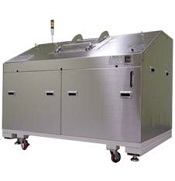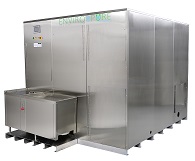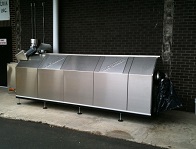 NATIONAL REPORT—Hoteliers looking to dramatically decrease the volume of food waste sent to landfill or elsewhere for composting are increasingly turning to food waste decomposition machines. These machines quickly reduce the volume of waste down to either drainable liquid or dry soil amendment. While just a few years ago there were just a handful of vendors selling the machines, today there are more than a dozen. Machines available work similarly but features vary from one supplier to the next. The good news for green lodging establishments is that suppliers are making it very affordable to implement the machines and are creating a service infrastructure to maintain them.
NATIONAL REPORT—Hoteliers looking to dramatically decrease the volume of food waste sent to landfill or elsewhere for composting are increasingly turning to food waste decomposition machines. These machines quickly reduce the volume of waste down to either drainable liquid or dry soil amendment. While just a few years ago there were just a handful of vendors selling the machines, today there are more than a dozen. Machines available work similarly but features vary from one supplier to the next. The good news for green lodging establishments is that suppliers are making it very affordable to implement the machines and are creating a service infrastructure to maintain them.
Properties ranging from the Waldorf Astoria in New York City to the La Costa Resort and Spa in Carlsbad, Calif. are using food waste decomposition machines. In some cases existing or pending commercial food waste bans are driving hoteliers to seek new food waste disposal solutions. Properties using the machines are benefiting in many ways—reduced waste hauling and labor costs, more efficient kitchen operations, a general reduction in environmental footprint associated with landfill impacts and truck pickups and deliveries, a cleaner work area, improved safety, and a reduction in waste-related odors, pests and vermin.
Some machines include built-in scales to allow users to more easily measure the weight of food waste being added—valuable data for hoteliers and hotel customers. All suppliers offer different machine sizes. At least one supplier will custom build a machine to meet demand needs. Another vendor is offering technology that allows one to monitor machine performance remotely. Suppliers have their own “recipes” for accelerating composting within their machines. Level of automation varies per machine type. Machine design inside the machine—what churns the mix—varies per supplier. Decomposition machines can work side by side or from a great distance with other machines that grind or chop food waste into more easily digestible pieces.
Some Suppliers to Consider
For this article Green Lodging News spoke with representatives of some of the suppliers who sell the machines. Green Lodging News attempted to contact as many suppliers as possible. Some did not return phone calls or e-mails. Here then is a summary of what some of the companies are currently offering.
BioHitech America Inc.’s Eco-Safe Digester transforms food waste into nutrient-neutral water that can be safely disposed via sewer systems. To accelerate the digestion process, microorganisms and wood chips are added. Microorganisms are replaced every two months. The wood chips are replaced every six months. Agitation and water helps to digest the food waste into grey water. The Eco-Safe Digester can digest up to 2,500 pounds of food waste every day. Smaller machine sizes digest up to 800 and 1,600 pounds. The Eco-Safe Digester features an on-board scale to help monitor daily, weekly and monthly pounds processed through the machine.
Lisa Giovannielli, Director, Sustainable Services for BioHitech America, says her company recently introduced the BioHitech Cloud that allows managers to monitor digesters from all over the world on their mobile devices. Digesters communicate real-time data about what an organization throws out to enable one to make adjustments to purchasing, inventory management, efficiencies, and food preparation. In addition, full reporting capabilities enable the tracking of all pounds of organic waste processed, dollar savings equivalents and carbon footprint reduction equivalents. Technology built into the machine also allows BioHitech America to know via alert messages when the machine has a problem.
“We want to know if there is a problem before the customer,” Giovannielli says.
BioHitech America customers can either purchase the machines and supplies and then purchase maintenance, or rent the machine, which includes a maintenance and supplies built in.
“People can rent a machine and turn it into a purchase,” Giovannielli says.
Wet & Dry Options from EnviroPure Systems
EnviroPure Systems, Inc. offers two types of systems: the EPW Food Waste Disposal system that converts food waste into water and the EPD Food Waste Disposal system that converts food waste into composting material. Linda Basinger, Key Account, Sales for EnviroPure Systems, says her company primarily sells the EPW system. EnviroPure customizes the size of each machine to meet the demands of the customer. Machines can process from 120 pounds to 15,000 pounds a day.
 EnviroPure Systems’ EPW system uses a vitamin mix (BioMix) as an additive to accelerate digestion. Water leaving the EPW system is treated before leaving the machine, ensuring that it meets BOD (Biochemical Oxygen Demand), FOG (Fats, Oils, Grease), and TSS (Total Suspended Solids) standards. As an option, a scale can be added to the machine.
EnviroPure Systems’ EPW system uses a vitamin mix (BioMix) as an additive to accelerate digestion. Water leaving the EPW system is treated before leaving the machine, ensuring that it meets BOD (Biochemical Oxygen Demand), FOG (Fats, Oils, Grease), and TSS (Total Suspended Solids) standards. As an option, a scale can be added to the machine.
The EPD system can process from 300 pounds to 800 pounds of food waste. A vitamin mix is added to the food waste which also includes cedar chips. No water is added.
Basinger says her company’s machines can be configured with food grinding systems. She cited an example of a configuration at the University of Illinois whereby food waste is pumped 350 feet to the EPW system.
EnviroPure Systems customers can either purchase or lease the machines. The company is working on a rental program.
Machines That Produce Fully Stable Compost
Focused Sustainability Consulting Group, LLC is a distributor for Vertal, which is the master distributor for the Big Hanna Composter. Big Hanna Composters come in five sizes and process from 330 to 550 pounds a week to 1,700 to 5,300 pounds a week. The continuous fed machines compost food waste in about eight to 10 weeks and can be placed indoors or outdoors.
“We have the only machine on the market that discharges fully stable compost,” says John Clifford, founder of Focused Sustainability Consulting.
Big Hanna machines require a bulking agent—wood pellets, for example, or sawdust. Water is added depending on the recipe. Sensors measure moisture and heat. Compostable flatware can be added as long as it is ground up or shredded first.
Customers can either purchase or lease to own the machines. “We are working on a straight lease or rent programs,” Clifford says.
Totally Green’s ORCA system uses microorganisms and bio chips (a plastic type of pellet) to accelerate the breakdown of food waste into a liquid that can be disposed of into the sewage system. The company offers three machine sizes—600, 1,200 and 2,400 pounds.
“The ORCA uses an aerobic decomposition process,” says Matt Shalhoub, general manager, Totally Green. “That means oxygen is involved to convert food waste into water in 24 hours.”
“There are no trucks coming to pick something up,” Shalhoub says. “Everything is digested on-site. You are taking a lot of the trucks off the road. It decreases methane gas emissions. There is no methane released at all.”
Unique Monthly Fee Structure
Totally Green charges a monthly fee to use its equipment. That fee includes maintenance and training. “We come up with an implementation plan and help the customer get the most out of the machine,” Shalhoub says. “We are not asking people to write a big check upfront.”
David Garcelon, Director of Culinary at the Waldorf Astoria New York, says his hotel currently has two 1,200 pound Totally Green machines. “Our stewards like it because it has reduced the weight of trash that has to be moved,” Garcelon says.
Integrated Veterans Services, LLC offers six sizes of its Ecovim dehydrators—66 pounds to 3,300 pounds. The dehydrators reduce food waste mass by 80 percent to 90 percent, on average, says Jack Fellman, manager, Integrated Veterans Services. The result of the dehydration is biomass resembling coffee grounds. Heat is used to accelerate the dehydration process.
Integrated offers lease, purchase or rental options.
GaiaRecycle offers 10 machine sizes—from 110 pounds a day to 4,400 pounds a day. During an eight to 11 hour processing time, the machines reduce food waste volume by up to 90 percent. The result is a dehydrated material that can be used for various outdoor applications. No microorganisms, enzymes, fresh water or other additives are required.
“It is not uncommon to put in 200 gallons and get 20 gallons out,” says Jim Gosnell, North America Gaia Distribution Group.
Fluid surrounding the composting vessel is heated to accelerate the composting process. Machines, which can either be purchased or leased, can be powered by electricity, steam, propane or natural gas.
Long Warranty with Power Knot Machines

Green Key Environmental Solutions’ Green Key Bio-Digester uses GK Bio-Zyme, microorganisms to accelerate the decomposition of food waste into grey water. Machine models range in size from 100 to 200 pounds to 1,500 to 2,000 pounds.
Food Cycle Science’s Food Cycler dehydrates and converts food waste into a sterile biomass. The biomass can be reused as soil amendment, compost accelerant, biofuels, animal feed, and pet food.
Waste to Water’s BIO-EZ machines, using BIO-HELPER microorganisms, break down food waste into liquid ready for sewage system disposal. Waste to Water offers three machine sizes: up to 350 pounds, up to 1,000 pounds, and up to 1,500 pounds. According to Dennis Soriano, CEO, the two larger machines, with a shredder, can process an additional 500 more pounds daily. BIO-EZ machines require bacteria inoculation just once annually, saving on operational costs.
“What differentiates us is the consistency of operation,” Soriano says. “Our machines require very little maintenance and our throughput is what we represent it to be. The machines operate day in and day out.”
BIO-EZ machines, made in the United States, require no supplemental heating. Heat is generated through the digestion process. Recycled HDPE pellets are used in the food mix and arms within the machine turn every 34 minutes to agitate the food waste.
Waste to Water customers can either purchase, lease or choose a capital lease option that turns ownership of the machine over to the customer for $1 at the end of 60 months.
Much to Consider Prior to Purchase
As with any significant kitchen-related capital investment there is much to consider when it comes to food waste decomposition machines: service availability, warranty, total cost of operation (water, energy, microorganisms, etc.), and ease of use. Of special concern with food waste decomposition machines, however, is what comes out of the machines.
“I would encourage any end user to make sure their vendor is providing independent lab results to substantiate their effluent meets BOD, FOG, and TSS municipal limits,” EnviroPure Systems’ Basinger says. “Municipalities are tightening their restrictions.”
Researchers at Loyola Marymount University tested both “dry” and “wet” machines and found issues with both. The dry machine produced a dehydrated product highly prone to fungus creation–proof that one needs to make sure the end product is a mature compost. And, the wet machine’s effluent exceeded recommended BOD levels significantly–not typical of all machines of course, but it can happen.
Glenn Hasek can be reached at editor@greenlodgingnews.com.






